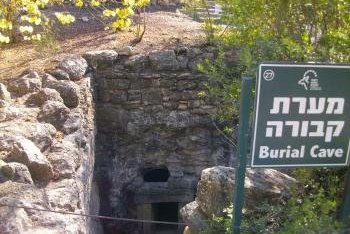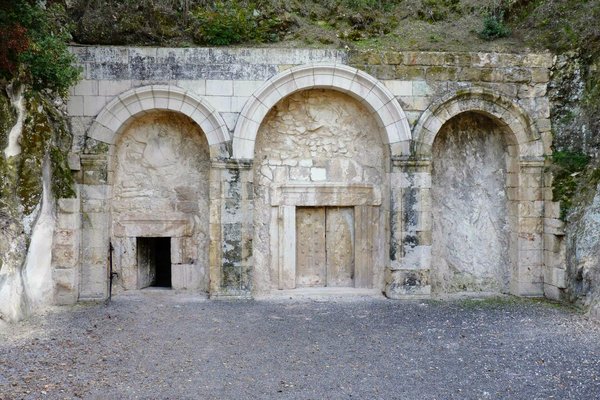Israel
Necropolis of Bet She'arim
The Necropolis of Bet She'arim - A Landmark of Jewish Renewal covers burial catacombs from an important period in Jewish history.
It comprises the archeological site of a Jewish town and 33 ancient rock-cut Jewish tombs. Rabbi Judah the Patriarch lived here, and it became the preferred burial place for Jews after they were barred from the Mount of Olives during the Roman occupation. The catacombs contain inscriptions written in Greek, Hebrew, Aramaic and Palmyrean and images showing the exchange with the Greco-Roman world.
Community Perspective: Obviously the site is popular mostly with Jewish visitors. Not all caves are accessible and to a WH chaser the two main caves nearest to the visitor center offer 90% of the overall value.
Site Info
Official Information
- Full Name
- The Necropolis of Bet She'arim - A Landmark of Jewish Renewal (ID: 1471)
- Country
- Israel
- Status
-
Inscribed 2015
Site history
History of Necropolis of Bet She'arim
- 2015: Inscribed
- Inscribed
- Type
- Cultural
- Criteria
- ii
- iii
Links
- UNESCO
- whc.unesco.org
- Official
-
- en.parks.org.il — Bet She‘arim National Park
All Links
UNESCO.org
- whc.unesco.org — whc.unesco.org/
Official Website
- en.parks.org.il — Bet She‘arim National Park
News Article
- Dec. 15, 2019 haaretz.com — Israeli UNESCO World Heritage Site Vandalized With Graffiti
- Feb. 17, 2017 breakingisraelnews.com — Mysterious Roman Gate Found in Seat of Ancient Sanhedrin
Community Information
- Community Category
- Archaeological site: Near Eastern
Travel Information
Recent Connections
-
Perfect Inscriptions
2015 -
Rock Cut Architecture
interior decoration of rock cut archite… -
Ossuary
"There's plenty of light and height in…
Connections of Necropolis of Bet She'arim
- History
-
-
Byzantine Empire and Civilization
findings at the big cistern
-
- Architecture
-
-
Mosaic art
Mausoleum Cave -
Rock Cut Architecture
interior decoration of rock cut architecture Man-made catacombs, with interior carvings: "In one cave, known as the Cave of the Coffins, "the mother of all menorahs" was discovered.""See www.jns.org
-
- World Heritage Process
-
-
First sites filling gaps cited by ICOMOS
Judaism 2015
-
Perfect Inscriptions
2015
-
- Religion and Belief
-
-
Jewish religion and culture
associated with Rabbi Judah the Patriarch, the spiritual and political leader of the Jewish people (OUV)
-
- Human Activity
-
-
Olive presses
-
Historical Graffiti
Incised and painted inscriptions in Hebrew, Aramaic, Palmyrene, and Greek: "Geographical references in inscriptions on the walls of the catacombs reveal that the necropolis was used by people from the town of Beit She'arim, from elsewhere in Galilee, and even from cities as far away as Palmyra and Tyre." (wiki)
-
- Constructions
-
-
Ossuary
"There's plenty of light and height in most of the areas, and temperatures inside are comfortable, making it easy to spend a few hours gazing at the sheer variety of impressive ossuaries, tunnels, inscriptions and symbolic decorations."See www.jns.org
-
Catacombs
a series of man-made catacombs (AB ev) -
Cisterns
The Sih cave was used as a water cistern during the British mandate period (AB ev) -
Necropolises
-
- WHS on Other Lists
-
-
World Monuments Watch (past)
Bet She'arim Archaeological Site (2002)
-
- Timeline
-
-
Built in the 3rd century
Became a favourite burial place after Rabbi Judah died in about 220 CE and was buried here (AB ev)
-
- WHS Hotspots
- WHS Names
-
-
Epic Subtitles
A Landmark of Jewish Renewal
-
News
- haaretz.com 12/15/2019
- Israeli UNESCO World Heritage Site…
- breakingisraelnews.com 02/17/2017
- Mysterious Roman Gate Found in Sea…
Recent Visitors
Visitors of Necropolis of Bet She'arim
- Alexander Lehmann
- Argo
- Assif
- Atila Ege
- Bamse
- Bill Maurmann
- Cezar Grozavu
- Christravelblog
- CynthiaW
- Danny L
- Dennis Nicklaus
- Dimitar Krastev
- Eva Kisgyorgy
- Filip Murlak
- Gary Arndt
- Grzegorz Andruszkiewicz
- Iain Jackson
- Ilya Burlak
- Ivan Rucek
- Jana and Matt
- Jarek Pokrzywnicki
- Jawnbeary
- Jay T
- John Smaranda
- Jon Eshuijs
- k2flake
- KateY
- Knut
- Lara Adler
- Lucio
- Lukasz Palczewski
- Maciej Gil
- Martina Rúčková
- MaYumin
- Michael Novins
- Mikan22
- Mikko
- Milan Jirasek
- Miloš Tašković
- Mkandasa
- nan
- Nihal Ege
- Patrik
- Philipp Leu
- Philipp Peterer
- Ralf Regele
- Roger Ourset
- Sergio Arjona
- sncjob
- Solivagant
- Stanislaw Warwas
- Szucs Tamas
- Tamara Ratz
- Tarquinio_Superbo
- Tatiana Nikulnikova
- tony0001
- Valentina
- Veronica
- Walter
- Wojciech Fedoruk
- Yongcheng Liu
- Zoë Sheng
Community Reviews
Show full reviews
Not many people who are neither students of Jewish history nor WH chasers will prioritize seeing Bet She'arim on their visit to Israel, but it has to be said that it is one of just a couple of WH sites in Israel that actually exceeded my expectations (albeit from a relatively low bar). I visited on an early morning in November of 2019 and pretty much "opened the site" for the day; only about half an hour later a few other people started to arrive, followed by a couple of tour buses.
The primary site consists of a few dozen caves that hold multiple Jewish burials from around the 2nd century AD. The two main caves nearest to the visitor center offer 90% of the overall value, while the rest provides one or two additional features and extend the range of the attraction. The Museum Cave, true to its name, offers a number of exhibits in a museum setting, from ancient pottery to fragments of stone decorations to models of the original structures at the site.
The Cave of the Coffins is also aptly, if not exactly creatively, named. This is a vast catacomb filled with all kinds of tombs and sarcophagi. The cave is roughly 75 x 75 meters in dimensions, but it feels larger as you walk inside its passages. Many coffins are decorated with patterns or animal motifs, and in one corner of it stands what is known as “the mother of all menorahs”.
…
Keep reading 0 comments
The Necropolis of Bet She'arim: A Landmark of Jewish Renewal is a cultural UNESCO World Heritage Site in Israel. It was inscribed into the list in 2015 and is part of Bet She’arim National Park.
Unlike many of the other World Heritage Sites in Israel, it primarily deals with post-Christian era Jewish Heritage, so it only tends to attract Jewish visitors. Nonetheless, it deals with an interesting part of Jewish history and is worth a visit if you are in the Haifa area.
Bet She’arim is located approximately 20km from Haifa and it easy to visit the park on a day trip from Haifa, Tel Aviv, or Jerusalem.
If you are planning to visit other World Heritage Sites in the area, it is in close proximity to Bahá’i Holy Places, the Sites of Human Evolution at Mount Carmel, Tel Meggido, and Acre.
Keep reading 0 comments
I was lucky to be in Israel shortly after inscription of Bet She'arim, otherwise most probably I wouldn't go there. That would be a pity, because this place is interesting, definitely above average of Israeli WHS. It is also very popular among locals – during our visit the site was full of people, but fortunately not overcrowded.
Important note – although the site is relatively easily reachable, if you go by car do not be mistaken by the name (as I was) – the site is not near the village of Bet Shearim, it is on the suburbs of Kiryat Tivon, small town not so distant from Haifa.
It should not be surprising that the site is popular among Jews – after destruction of Jerusalem Temple the most important Jewish court- Sanhedrin – was moved here and the place was considered the most prestigious necropolis for well-off Jews when the cemetary on Olive Mountain was not accessible. That popularity stemed from Judah the Nasi (main codificator of Mishna, Jewish code of laws), who wished to be burnt here.
The necropolis of Bet She'arim is not big and the core area may be visited in about 1-2 hours. The main attractions are of course the tombs, some of them gathered in caves (the largest burial cave is 75m long and wide). Unfortunately, despite warnings like „Whoever dares to open this tomb will die the horrific death”, literally all the tombs were robbed, even if they were protected by huge stones. Anyway, …
Keep reading 0 comments
This site was a sacred Jewish burial place during the late Roman period, when Beth Shearim was among the most significant Jewish sites. The site became important when Rabbi Judah the Nasi was buried there, which attracted many other Jews who wishes to be buried nearby. The site is full of catacombs where you can see ornated sarcophags covered with Greek inscriptions. Some of the entry gates are also impressive. The site is not too big and can easily be covered in a few hours. The site is conveniently located next to Nazareth at the Yizrael Valley, where you can also visit Seppheris and Megiddo, itself a WHS.
Keep reading 0 comments
